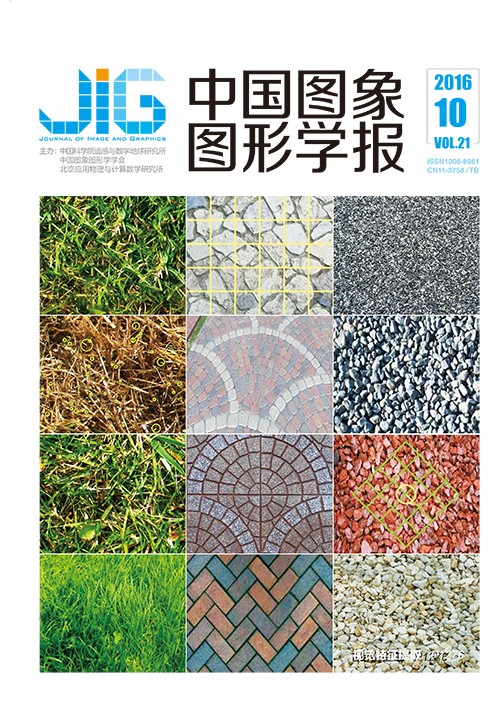
边缘追踪模型与SURF检测结合提取天绘影像机场目标
摘 要
目的 遥感影像提取识别机场目标是遥感领域研究的热点。但是大多研究仅使用被裁剪的影像进行提取识别,由于处理速度等原因很少使用整景高空间分辨率遥感影像提取机场目标。大多数研究是先提取出图像中的直线,根据直线确定机场跑道再确定机场目标,但高分辨率图像提取的直线不仅是机场跑道的,还有可能是高速公路、铁路、大型厂房的外墙、耕地边缘、山脉、地层等,如何区分提取的直线是机场跑道很少被研究。很多研究提取的都是大型机场目标,没有对小型机场进行提取识别,另外如果图像中同时有两个机场应该如何提取也没有被研究。天绘具有数据实时回收,数据全球覆盖等特点,本文将使用高空间分辨率天绘影像(6 000×6 000 像素)提取机场目标。天绘影像地物类型复杂,细节丰富,仅使用一般的空间滤波或边缘探测方法会导致检测结果中有过多的噪声和伪边缘,致使机场目标识别不出来,所以建立了一种以边缘提取追踪模型和SURF(speeded up robust features)检测结合的检测方法和提取流程,达到机场目标识别的目的。方法 边缘提取追踪模型是建立在边缘提取基础上。首先对天绘影像进行滤波处理消除噪声,再对图像进行梯度幅值和法线梯度方向的计算,并利用改进的非极大值抑制方法找到梯度图像中局部变化的最大值,删掉其他值,获得单像素边缘图像,然后对边缘图像进行边缘轮廓线追踪提取出边缘轮廓线,最后使用直线检测和SURF检测方法识别出机场目标。结果 使用本文方法成功地识别了4景天绘卫星图像中的机场目标。借助改进的非极大值抑制和边缘轮廓线追踪提取方法有效地提取了影像中所有地物的边缘,识别出的地物边缘都是清晰的、单像素的边缘,对地物边缘轮廓进行直线提取,并在提取直线的基础上使用SURF检测获得图像中的机场目标。利用天绘卫星图像成功在2景图像中分别提取出一大、一小两个机场,在另外两景图像中分别各提取出一个机场,顺利地实现了用天绘卫星图像提取识别机场目标的过程。结论 本文提出的机场目标提取方法十分有效,该方法不仅适合于天绘卫星遥感数据,还适用于和天绘卫星类似的其他遥感卫星数据。其中对非极大值抑制方法的改进能够提取出更准确的边缘,也能提取出更细微的边缘, 抑制虚假边缘的产生,对提取小型机场有帮助。
关键词
Detecting airports in high-resolution Mapping Satellite using edge tracing-SURF method
Han Xiaoqing1, Du Hongyue2(1.Beijing Research Institute of Uranium Geology, Beijing 100029, China;2.China mapping technology Service Corporation, Beijing 100088, China) Abstract
Objective Automatic airport recognition from a remote sensing image is popular in the remote-sensing community. However, most studies extracted objects from cropped images because performing the same task on a high-resolution image is time consuming. Most studies extracted the image of a straight line, which is determined based on airport runways, and then determined the target; however, the straight line is not only a high-resolution image extraction of airport runways, but may also be of highways, railways, external walls of large-scale plants, marginal lands, mountains, formations, and other structures. Methods of distinguishing extracted straight runways are rarely studied. Furthermore, these methods focused on a single and large airport instead of a small one, and few of these methods studied multiple targets. China has recently launched a high-resolution mapping satellite that has global reach data acquisition and real-time data transmission ability. Beyond surveying and mapping, the mapping satellite can also be used for land cover classification, land object recognition, and resource exploration. In this paper, mapping satellite imagery is used (with 6 000×6 000 pixels) as a source to detect airport images that have rich details and complex land covers. Traditional spatial filter and edge-detection methods tend to fail in airport detection because of noise and false edges. To solve this problem, an edge-tracing model combined with speeded up robust features (SURF) detection is proposed. Method This paper presents a new method that combines edge tracing and SURF to extract airport images. Edge tracing is based on edge extraction. First, filtering is applied to suppress noise. Then, gradient magnitude and gradient direction along norms are calculated. Greatest local variations of gradients found by improved non-maximum suppression (NMS) method are deleted to obtain a single-pixel edge image. A contour line is extracted from this edge image. Finally, airports are detected through line detection and SURF. Result Airports in four mapping satellite images are successfully recognized using the presented method. Improved NMS and edge-contour tracing are helpful for edge extraction. Most of the object edges are successfully detected and are considerably clear with single-edge width. After the line detection for ground objects, a SURF detector is applied to recognize airports in the image. Two airports with different sizes, one large and one small, are successfully detected and extracted from two mapping satellite images, which demonstrate the effectiveness of the proposed method. Conclusion The proposed method is considerably effective in airport detection. The airport detection method proposed in this paper is suitable not only for remote-sensing data of mapping satellites but also for application on day-painting satellites, such as other remote-sensing satellite data. The improved NMS method can extract more accurate and thinner edges while suppressing false edges. This method is extremely helpful for airport detection. The edge-tracing model can extract contours in different directions accurately, thereby improving line detection accuracy. Many ground targets, such as roads, railways, croplands, walls of factories and mines, mountains, strata, and others, can be recognized from line features. Thus, SURF is used to distinguish airports from these objects. Our experiments show that many key points extracted by SURF lie on the intersection of different lines inside the airports. Based on this observation, the airport can be identified by scanning images to find lines and key points.
Keywords
improved non-maxima suppression edge contour tracing extraction speeded up robust features (SURF) detection automatic airport extraction Mapping Satellite imagery
|



 中国图象图形学报 │ 京ICP备05080539号-4 │ 本系统由
中国图象图形学报 │ 京ICP备05080539号-4 │ 本系统由